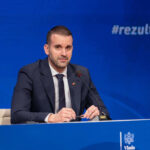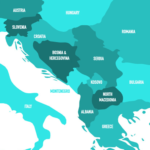Countries of the Western Balkans have been putting a major focus on strengthening their armed forces over the recent years. Increasing their defense budgets allowed the nations to recruit more servicemen and procure modern weapons. Serbia champions the process, declaring the intention to achieve greater security. But is it really the case?
Here are the main reasons behind the ongoing arms race in the Western Balkans.
1. Russia’s full-blown aggression against Ukraine that poses a powerful challenge to global security, opening doors to more crises, including in the Western Balkans. A large-scale war in Europe terrified some regional leaders and gave some revenge hopes to others, which contributed to regional instability.
2. Unsettled disputes between Kosovo and Serbia, which in the most negative scenario could provoke a military conflict. In recent years, Serbia has repeatedly amassed its units, including armored force, on the borders with Kosovo, and scrambled its combat aircraft. The latest and tensest escalation was observed in September 2023, when an armed clash took place between a Serbian paramilitary group and Kosovo police near the village of Banjska. Belgrade and Pristina demonstratively stepped up their army/police arming programs and almost simultaneously spoke up on the need to reinstate/introduce mandatory conscription, which made things even more explosive.
3. Unstable situation in Bosnia and Herzegovina. Statements by the President of Republika Srpska, Milorad Dodik, about the plans for the secession from BiH and the decisions of the RS authorities aimed at implementing these plans constantly keep the region at risk of escalation.
The open moral and political support for Dodik on the part of Serbia’s leadership makes Belgrade an accomplice in firing up dangerous processes in Bosnia and Herzegovina.
4. Serbia’s struggle for military regional leadership. Serbia saw the accession of Croatia, Albania, North Macedonia, and Montenegro to NATO as a challenge and began strengthening its own military-industrial complex. A particularly nervous reaction in Belgrade was caused by the modernization of the Croatian army. Apparently, Serbia still perceives its western neighbor primarily as a former military adversary.
The Serbian leadership considers the current policy pursued by the Kosovo government, which is aimed at arming and strengthening their Security Forces, another pretext for the “competition”. These are, first of all, plans to arm with American Javelins and the signing of a military agreement with Türkiye . Despite the obvious incomparability of Serbia and Kosovo’s military potentials, this argument is voiced by Serbia’s top political and military leaders.
Some figures on the arms race are seen in the table below, which compares data between 2013 and 2023:
| Defense spending ($, mln) | Defense spending to GDP ratio | Per capita ($) | Army ranking (from a total of 145 armies) | Army manpower/ including active duty | |
| Albania | 180/386 | 1.41/1.58 | 62/100.7 | 90 | 9,100/6,600 |
| BiH | 197.6/184.5 | 1.09/0.81 | 55.8/56.8 | 116 | 18,700/12,700 |
| Kosovo | 48.6/107.6 | 072/1.13 | 26.7/55.0 | 135 | 5,500/3,500-5,000 |
| N.Macedonia | 126.5/225.0 | 1.10/1.90 | 60.9/108.1 | 110 | 9,000/7,500 |
| Serbia | 918.8/1.48млрд | 1.90/2.28 | 103.1/164.8 | 56 | 627,000/25,500 |
| Croatia | 957/1.18млрд | 1.63/2.17 | 223.7/322.4 | 66 | 36,425/14,325 |
| Montenegro | 64.8/102.1 | 1.45/1.6 | 103.6/156.1 | 129 | 7,850/2,350 |
Sources: Stockholm International Peace Research Institute, SIPRI Year Book 2024. CIA Factsbook 2024. Military Strength Ranking/Global Firepower 2024. Balkanski monitor odbrane 2023.
Concepts of Serbia’s defense policy
The situation around Serbia, the current leader in the regional arms race, deserves special attention. It is based on the three main concepts.
The first one is total defense, which implies prioritizing the development of the defense industry and involving various population strata in defending the country. To this end, the government is set to reinstate military draft (at least in the form of volunteer recruitment).
The concept of total defense was declated by the country’s President, Aleksandar Vučić, at a meeting with the country’s military and political leadership regarding the analysis of the state of the Serbian army, which took place on January 30. Without a strong army, Serbia will cease to exist, he emphasized, explaining the need to strengthen the defense industry and the armed forces.
The second concept is the modern-day “Greater Serbia”, which provides for “protection” of all Serbian citizens across the region, regardless of their country of residence. It is significant that the President of Republika Srpska, Milorad Dodik took part in the said meeting in Belgrade where he thanked Serbia for the protection of all Serbs, including in Republika Srpska.
The third concept is military neutrality. Belgrade uses the country’s neutral status as an argument for increasing army spending.
Non-aligned Serbia actually openly positions itself as an opponent to NATO, despite Belgrade’s statements of partnership with the Alliance, and does everything to strengthen its position in this competition.
The objective of this policy, pursued by the Serbian leadership, is not a direct military confrontation with NATO. The actual objectives are as follows:
• increasing political influence on the Western Balkans / former Yugoslavia;
• convincing Pristina and its Western allies of Belgrade’s determination and availability of resources to protect its interests in Kosovo;
• demonstrating the potential capability to protect Republika Srpska within Bosnia and Herzegovina.
Serbia is obviously trying to strengthen its regional posture and weight on the international stage primarily through a military upgrade. And although currently Belgrade is using the arms race as an element of political or hybrid activity, walking farther along this path will make the situation in SEE more and more dangerous.
In the photo (mod.gov.rs): President and Supreme Commander of the Armed Forces of Serbia, Aleksandar Vučić, visited the exhibition of weapons and military equipment of the Serbian Army in Niš on February 14, 2024. At the exhibition, the Repellent electronic warfare system, which Serbia received from Russia, was presented for the first time, designed to counter unmanned aerial vehicles.



